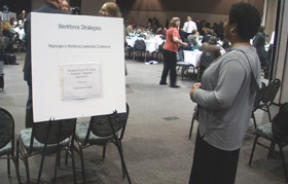Surely you have heard the adage: Go to college, and youll get a good job. It seems simple enough, right? But at a Tacoma business conference this week, presenters highlighted how globalization and marketplace changes have complicated this simple logic.
The conference, entitled Workforce Strategies: Leading in a Global Economy and created by Washington State Universitys Conferences and Professional Programs department, highlighted tools and resources available for businesses to compete in a global economy and employees to advance their careers in response to this new economy.
The event kicked off on Tuesday with three keynote speakers offering various perspectives on the issue of globalization.
We tend to get excited about outsourcing, Dr. John Mitchell, U.S. Bancorp’s western region economist, told attendees. But this global economy stuff isnt new. Mitchell pointed to industries that supported the early westward expansion of the United States and once-popular textile industries — both of which have largely disappeared due to changes in technology, innovation, and need. There is a dynamism of laws, technology, tastes and competition that affects the labor market, he added. This has been going on for some time now. He argued that one consideration for addressing this ever-changing job market is helping people through change, not trying to stop the change.
Dr. Margaret Hallock, director of the Wayne Morse Center, focused on globalization largely from a workers perspective. The anxieties of workers are real and rational, she explained. No matter how high ones skills, he or she can be impacted by the international, downward spiral of wages.
Dr. Hallock told the audience that as many as 14 million U.S. jobs are vulnerable to outsourcing, and that globalization, outsourcing, and job loss feels more dynamic than simply the turning of a labor market. If you talk on a phone, sit at a desk, or use a computer, you are vulnerable, she added.
Finally, Bill Center, president of the Washington Council on International Trade, focused on the more basic strategies of eliminating incentives for outsourcing and improving the educational system. America, collectively, underestimates the magnitude of the challenge of globalization, he said. To remain competitive, Center pointed to the need to improve efforts to prepare high school students for college. People without a basic education cant make a living wage, Center said. Policies should reflect the need to provide lifetime learning opportunities and preparing high school students for college.
The two-day conferences morning keynote presentations were followed by breakout sessions that covered a comprehensive range of workforce development topics, including:
*Up-Skilling Current Workers: Linking Economic Development and Economic Opportunity
*Industry Cluster Strategy: Whats Ahead for Washington?
*Health Workforce Shortages: Innovations in Other States
*Career Navigation: The New Basic Skill
One notable breakout session covered wage progression — specifically, de-mystifying the traditional understanding of an employees ability to move up the ladder.
Amy-Ellen Duke, a policy analyst at the Center for Law and Social Policy, made it very clear that simply finding a job was not enough. Prospective employees should seek jobs with higher wages, ample benefits, and opportunities for new and incumbent employees to acquire new skills.
The problem with this plan? Current federal policy focusing on reducing the unemployment rate, not creating jobs with opportunities or advancing the skills of existing employees.
Federal policies right now focus on getting jobs for unemployed people — not improving the skills of incumbent workers, Duke explained. Its not the best environment right now for incumbent employees to find federal programs to acquire new skills. A program with an employers buy-in is the best right now.
Duke cited several strategies for employees looking to progress their jobs and wages: partnerships between employees and employers, connecting people with jobs, and upgrading employee skills. Even still, Duke added, these strategies are hardly cure-alls. A worker may be able to acquire new skills and position herself for promotion and wage increases, but she cannot control a poor economy or a declining job market.
Rhonda Simmons, the executive director of Seattle Jobs Initiative (SJI), offered a unique perspective on the topic of wage progression and career advancement. Simmons works with a population of job-seekers with criminal records, histories of alcohol or drug abuse, and low-income or homeless challenges. SJIs goal is to avoid placing clients in dead-end jobs with no opportunities for advancement. Despite track records that would alarm most employers, Simmons stresses the need for her clients to earn more than minimum wage.
And the issue of wage progression is unique to SJIs clientele. If an employee earning $10 an hour is given the opportunity to advance her career and earn more money, she may turn down that opportunity. Why? Such a move would change her earnings status and result in a reduction state or federal benefits such as childcare or healthcare. You have to know who you are working with, Simmons explained. Its not a one-size-fits-all situation.
Finally, Marc Baldwin, the assistant commissioner of the Office of Policy and Research at the Employment Security Department, illustrated three common tracks for wage progression: the career ladder concept (starting out on the ground-floor and working your way up to CEO); steps and landings (climbing up to a certain level within one company, and moving into a higher position at another company); and the random walk strategy (unpredictable career changes). Despite the track, Baldwin explained that several factors are important to wage progression: the size of the company (larger companies are better); the companys increase in employment (higher rate is better); and the industry (certain industries are better than others).
As this conference illustrated, strategies for wage progression and job security arent as simple as going to college and landing your dream job. There are forces at work — changes in the market, globalization, technological innovations, and employee characteristics — challenging employees and businesses.






